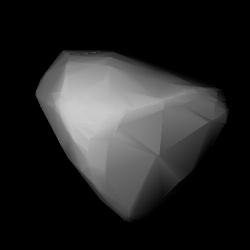Physical characteristics
In the Tholen-like taxonomy of the Small Solar System Objects Spectroscopic Survey (S3OS2), Sophia is a common, stony S-type asteroid, while in the survey's Bus–Binzel (SMASS) taxonomic variant, it is an Sl-subtype, which transitions from the S-type to the uncommon L-type. [6] [12] In the SDSS-based taxonomy, it is an L-type asteroid [13]
Rotation period and poles
In December 2000, a rotational lightcurve of Sophia was obtained from photometric observations by Bill Holliday in New Braunfels, Texas. Lightcurve analysis gave a well-defined rotation period of 20.216±0.008 hours with a brightness variation of 0.30±0.02 magnitude ( U=3 ). [10] Between 2005 and 2013, additional observations by French amateur astronomers Laurent Bernasconi, Etienne Morelle and René Roy gave a tentative period of 20.28 hours with an amplitude between 0.25 and 0.61 ( U=2/2/2 ). [14]
Modeled lightcurves by Josef Ďurech and Josef Hanuš, using photometric data including from the Lowell Photometric Database and from the Wide-field Infrared Survey Explorer (WISE) were published in 2018. It gave a concurring sidereal period of 20.2221±0.0002 and 20.2222±0.0001 hours, respectively. Hanuš also gave two spin axes at (235.0°, −52.0°) and (47.0°, 84.0°) in ecliptic coordinates (λ, β). [15] [16] [11]
Diameter and albedo
According to the surveys carried out by the NEOWISE mission of NASA's WISE telescope, the Infrared Astronomical Satellite IRAS, and the Japanese Akari satellite, Sophia measures (27.495±0.197), (28.42±4.5) and (29.65±0.42) kilometers in diameter and its surface has an albedo of (0.234±0.042), (0.2188±0.091) and (0.207±0.007), respectively. [7] [8] [9] The Collaborative Asteroid Lightcurve Link derives an albedo of 0.2377 and a diameter of 28.54 kilometers based on an absolute magnitude of 9.9. [11] Alternative mean-diameter measurements published by the WISE team include (28.201±1.301 km) and (28.804±0.212 km) with corresponding albedos of (0.244±0.047) and (0.2205±0.0481). [6] [11]
This page is based on this
Wikipedia article Text is available under the
CC BY-SA 4.0 license; additional terms may apply.
Images, videos and audio are available under their respective licenses.
